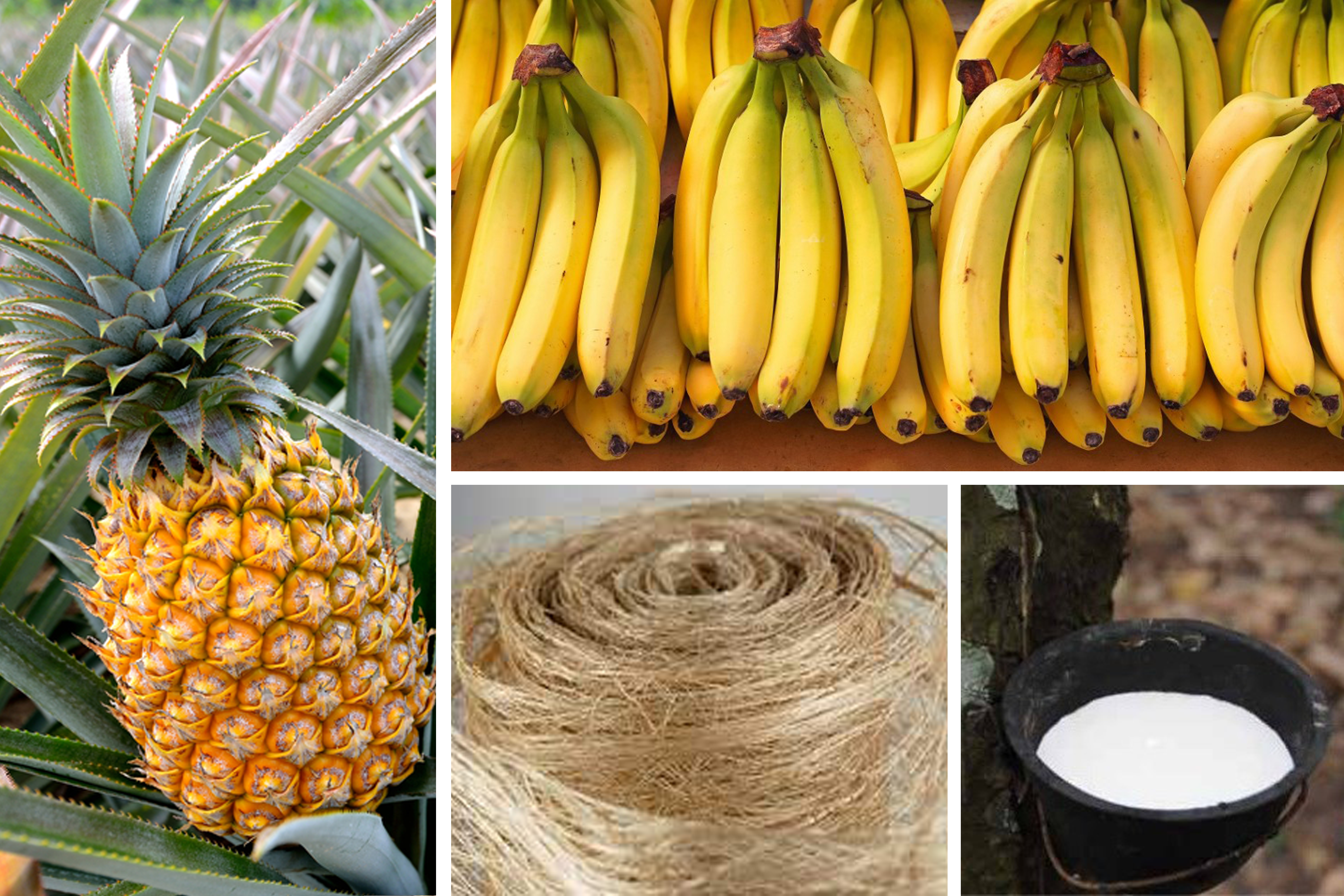
(Fourth of seven parts)
Banana and pineapple rank as the country’s top agriculture exports, aside from coconut oil and other coconut products.
In 2019 alone, Philippine banana exports reached $1.95 billion (B ), $1.64 B in 2020, and roughly $920 million (M), from January to October 2021, according to the Philippine Statistics Authority (PSA). Further, exports of pineapple products (canned, juice, concentrates) amounted to more than $300 M, from January to October 2021.
With such huge earnings, the Department of Agriculture (DA) aims to sustainably increase the production of the two major Philippine fruits, including other traditional and emerging high-value crops that have export potentials and thus could give farmers higher incomes.
“We enjoy a comparative advantage in banana and pineapple, and for this reason, we at the DA invest in the development of the high-value crops subsector through our High Value Crops Development Program (HVCDP). Undoubtedly, high-value crops can provide farmers and their families, entrepreneurs and other players in the agriculture value chain sustainable income,” said Agriculture Secretary William Dar.
“This year, the ‘OneDA Family’ will continue to encourage more farmers to shift to crops that are more sturdy, resilient, and with ready market, thus more profitable. This in addition to providing them production support, post-harvest facilities, and value-adding mechanisms to make Philippine farm and fishery products more globally competitive,” he added.
“Further, we will maintain our position as a major exporter of banana by containing the ‘Panama disease,’ and exploring more markets for our pineapple. In partnership with the private sector and farmers’ groups, we will intensify our efforts in promoting crops with high export potentials like mango, cacao, coffee, rubber, and okra,” the DA chief said.
He said the country looks forward to more exports of fresh Cavendish bananas to Japan, as it recently lifted the 100 percent mandatory testing for Philippine banana exports. To date, the DA’s Bureau of Plant Industry (BPI) said there are 82 Philippine companies exempted from 100 percent inspection, after they have shown high level of compliance to the set audit criteria and all phytosanitary requirements imposed by Japan.
Last year, the Philippines also successfully penetrated the South Korean market for fresh okra, benefiting thousands of farmers in Luzon. This is in addition to the existing Japanese market for “lady fingers,” which serve as a side dish or salad ingredient.
The market access breakthrough was initiated by the Philippine Okra Producers and Exporters Association in partnership with the DA-BPI.
With this favorable development, Secretary Dar urged the DA-HVCDP and other concerned “OneDA Family” agencies to be aggressive in forging partnerships with the private sector, fruit and vegetable industry associations, and farmers’ groups to expand and explore other potential export markets, and come up with more innovative and attractive packaging, and marketing strategies.
Providing HVC farmers needed support
In 2021, the DA-HVCDP provided farmers and other high-value crops (HVC) industry stakeholders the following support services and assistance, in terms of: production; extension, education and training; research and development (R&D); agricultural machinery, equipment, and facilities; and irrigation equipment and systems.
With a regular budget of P1.8 B in 2021 and a supplemental budget of P1.4 B under “Bayanihan 2,” the DA-HVCDP, led by Undersecretary Evelyn Laviña, has implemented the following:
- Provided seeds and planting materials of high-yielding crop varieties — such as vegetables, garlic, and onion and planting materials such as mango, banana, pineapple, coffee, cacao, rubber — to more than 3,800 farmers’ cooperatives and associations (FCAs), private groups and individuals;
- Expanded HVC production areas to 11,705.40 hectares (ha);
- Provided HVC farmers 332,180 kg of fertilizers and 294 liters of flower inducers;
- Provided extension, education and training to 6,613 farmers; and conducted 214 farmers’ field schools (FFS), training of trainors, school-on-the-aìr, and specialized training, in tandem with the DA’s Agricultural Training Institute (ATI) and RFOs;
- Conducted 443 techno-demos in tandem with the DA-BPI to rehabilitate old and unproductive coffee, cacao, mango, and pili trees in nine regions;
- Funded 61 R&D projects through DA-BAR on such crops as banana, coffee, cacao, abaca, rubber, coconut, mangosteen, pummelo, pili, onion garlic, yam, sweet potato, ginger turmeric, soybean, adlay, mungbean, and bamboo; and control of banana Fusarium wilt (Panama disease), mango Cecid fly, several garlic viruses, and onion armyworm;
- Established 5,056 community-based and modern food production facilities, including greenhouses, nurseries, urban agriculture projects, and school gardens;
- Provided 6,573 FCAs with various farm machinery and equipment, such as 4-wheel tractors, sprayers, cultivators, and postharvest equipment and machinery, like depulpers, roasters, dryers, and hauling vehicles; and
- Installed pump and drip irrigation systems, and developed springs and shallow tube wells, covering 794 hectares and benefiting 395 FCAs with thousands of farmer-members.
Food safety, export market expansion
The DA-BPI also implemented needed policies to ensure food safety, prevent entry of transboundary plant pests and diseases, and expand export market access for fruits and vegetables. These included:
- Appointed or designated food safety officers at major ports of entry;
- Established protocols for the conduct of: risk categorization for the importation of plant food; risk profiling for food safety; and risk categorization for primary production, processing, storage, transport, and distribution of plant food;
- Distributed 7,354.82 kilograms (kg) of assorted vegetable seeds (lowland, upland, and legumes) to 785 individuals and 109 groups; 58,322 pieces of planting materials of coffee, cacao, sweet potato, ornamentals, and medicinal and herbals to 1,707 individuals and 292 groups;
- Developed protocol for the micropropagation via tissue culture of pathogen-free ginger seeds and planting materials; and
- Evaluated 14 bush and nine pole bean accessions that were collected, grown, and characterized at the BPI Baguio experimental farm for three cropping seasons, from November 2018 to April 2021;
Growing veggies in urban areas
With community lockdowns due to the pandemic, backyard gardening, growing of ornamentals, and urban agriculture, in general, became popular.
Secretary William Dar institutionalized last year an Urban and Peri-urban Agriculture Program (UPAP) to sustain efforts in previous years, and more importantly develop additional production areas around Metro Manila that could supply the metropolis with vegetables and other basic food commodities in case of lockdowns and natural and man-made calamities that constrict transport of the same from traditional production regions.
To date, the DA-UPAP has gained more than 1,200 partners from other national government agencies, LGUs, barangays, civil society organizations (CSOs), the private sector, village and homeowners’ associations, and individuals. They are mostly from Luzon (89%) and the rest from Visayas and Mindanao.
Also, the DA-UPAP has provided partners with diverse urban gardening modules or technologies on mushroom production, community gardening, modern urban farming, school gardens, containerized gardening, and “Gulayan sa Bakanteng Lote.”
Further, it has accomplished the following:
- Served a total of 4,580 households and communities, provided with 2,299 kg of assorted vegetable seeds, 121,502 pieces of seedlings, and 30,399 bags of fertilizers and garden soil;
- Upscaled urban agriculture projects in 56 locations with modern technologies like hydroponics and vertical farming;
- Distributed a total of 137,851 tools and equipment to beneficiaries through DA Regional Field Offices (RFOs);
- Conducted 901 face-to-face and online trainings on hydroponics, urban mushroom production and vegetable production to ensure “Food Always in the Home” or FAITH, through DA’s BPI, Agricultural Training Institute (ATI) and RFOs;
- Conducted related agriculture and livelihood projects like raising rabbits, goats and chicken; and
- Helped sell vegetables and other products through the DA-AMAS Kadiwa ni Ani at Kita outlets and other agri fairs.
World’s top abaca producer
The Philippines does not only have a comparative advantage in abaca or “Manila hemp,” but has the distinction as the world’s largest and leading producer, supplying 85 percent of global requirements.
Thus, given adequate budgetary support and investments, its export revenues could grow exponentially in succeeding years, said Secretary Dar.
During the last decade, the country earned an average of $97 million (M) in abaca exports, according to the DA’s 2018-2022 abaca industry roadmap. Exports are composed mainly of fiber and pulp for specialty papers, including paper currencies, tea bags, and meat casings. The rest are yarns, cordage, fibercraft, and fabrics. There are exported mainly to the United Kingdom and Japan.
The DA through the Philippine Fiber Industry Development Authority (PhilFIDA) implemented last year two major initiatives: Abaca Tuxy Buying Special Project (ATBSP); and Abaca Under Coconut Farm.
The ATBSP organizes and empowers farmers to increase their productivity and incomes, as it aims to cut in half the traditional 12-stage abaca fiber extraction/harvesting to just six (topping, tumbling, tuxying, tuxy bundling, transport/hauling and trading/selling). With this initiative, farmers could increase abaca fiber production, reduce production cost, and therefore earn higher income.
The project was launched in June 2021 in Caramoran, Catanduanes, where the DA-PhilFIDA constructed project facilities and procured needed equipment.
On the other hand, the integrated abaca-coconut farm project, which is done in collaboration with the DA’s Philippine Coconut Authority, targets to cover 1,000 hectares with a P50-million budget, from the Senate of the Philippines through Senator Sonny Angara, according to PhilFIDA. As of November 2021, 773 hectares of coconut farms were intercropped with abaca. The project is expected to provide farmers with an additional annual income of P80,000/ha.
Boosting rubber production, exports
The Philippines is also among the top producers and exporters of natural rubber in the world, shipping out more than 158,300 MT in 2020, worth P4.87 billion (roughly $97.4 million), according to the PSA.
Thus, the DA through the Philippine Rubber Research Institute (PhilRubber) aims to further beef up production for both domestic and export markets by promoting modern and innovative rubber tree farming technologies, distribution of high-quality planting materials, and provision of extension and technical services.
The DA-PhilRubber said these twin initiatives are currently piloted in both traditional and in mining areas, at least five hectares each site planted to 5,000 trees, to showcase and commercialize mature R&D technologies. ### (DA StratComms)














